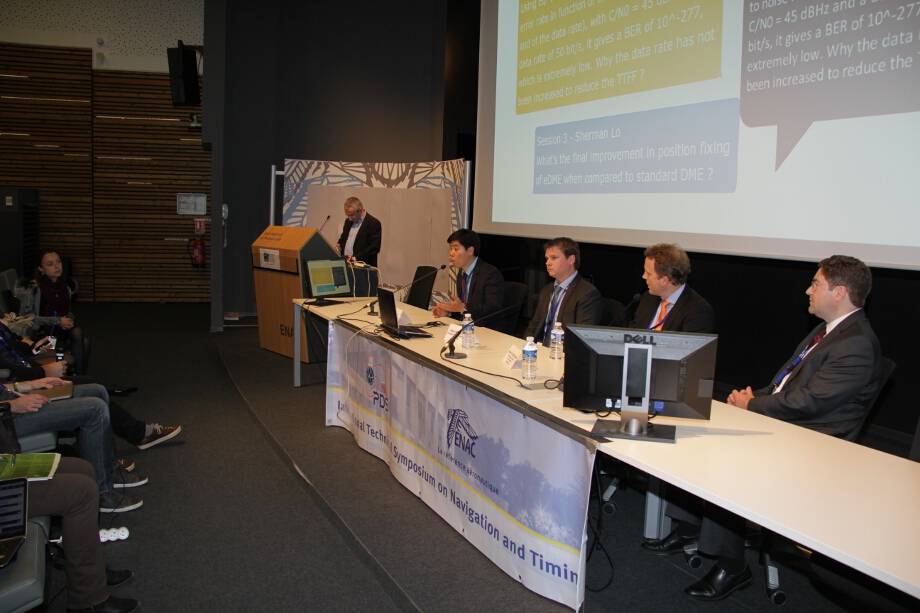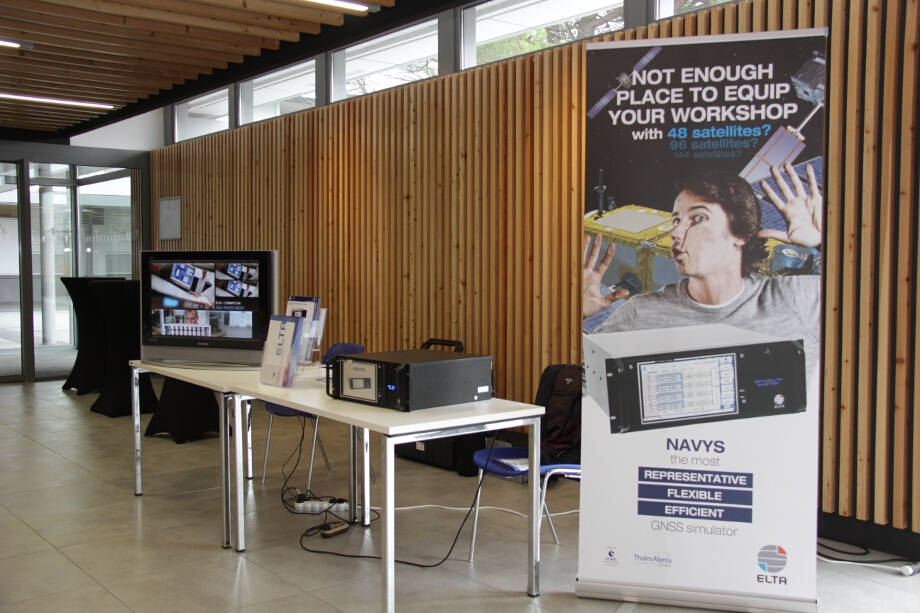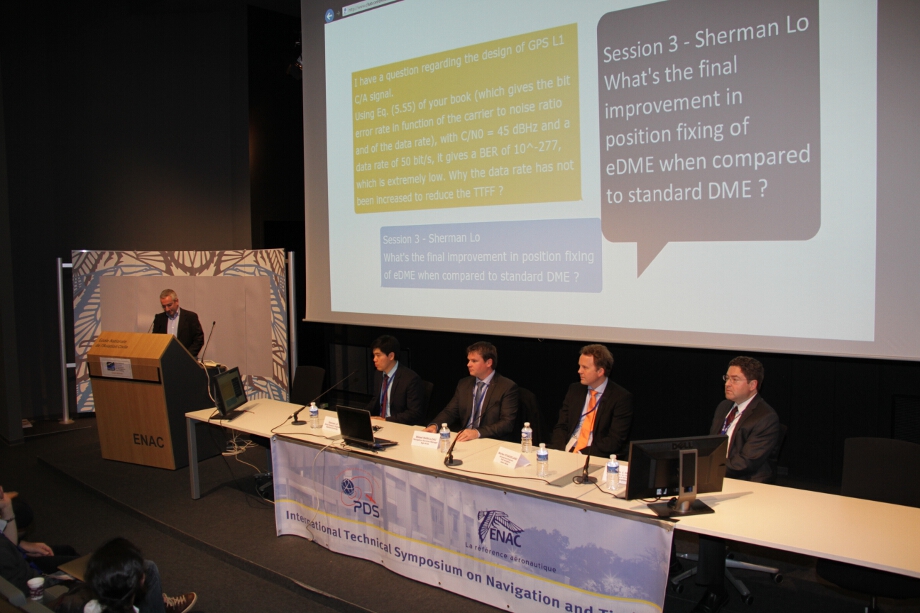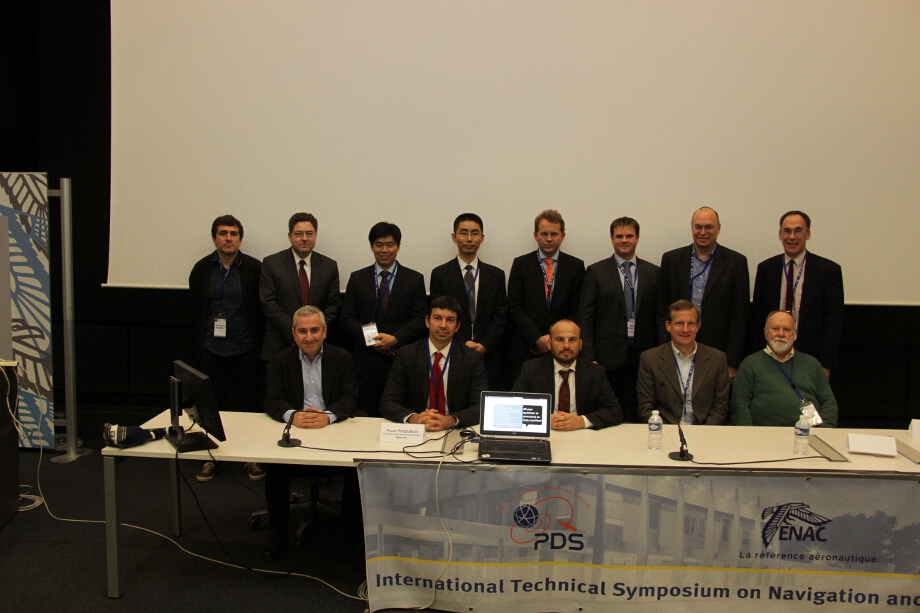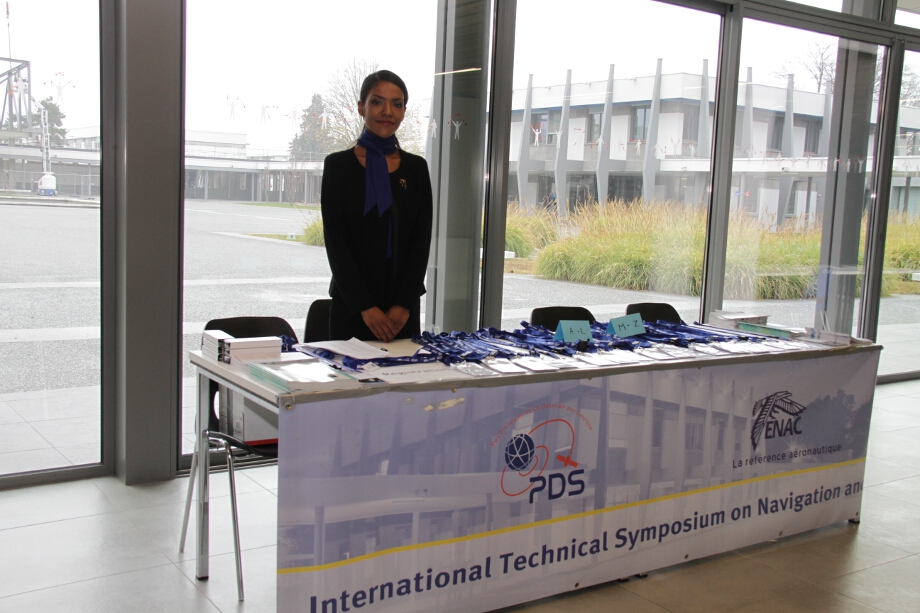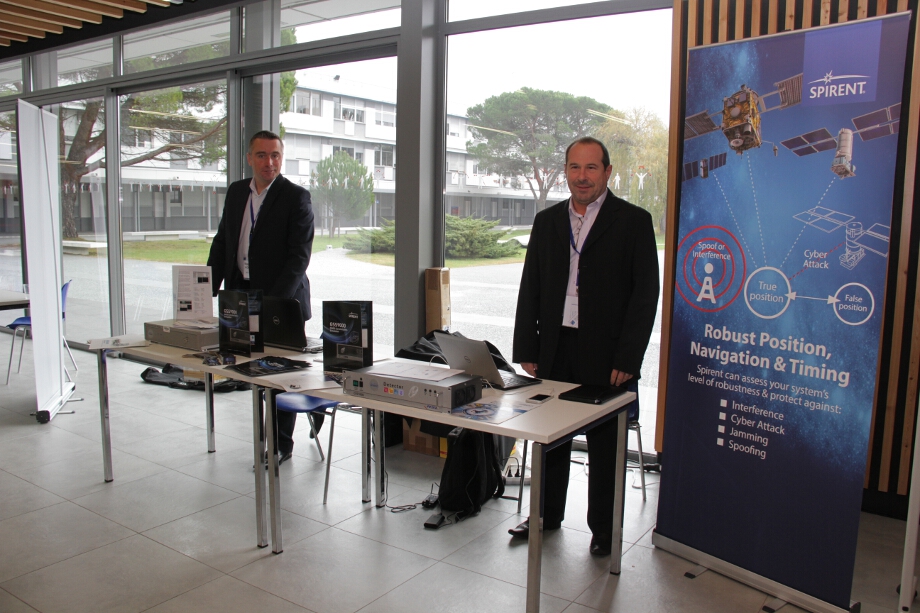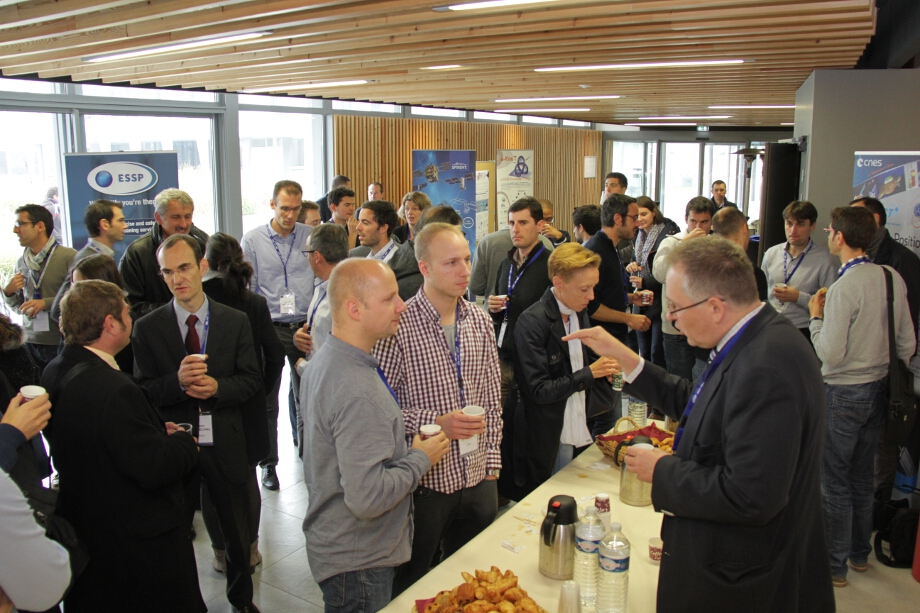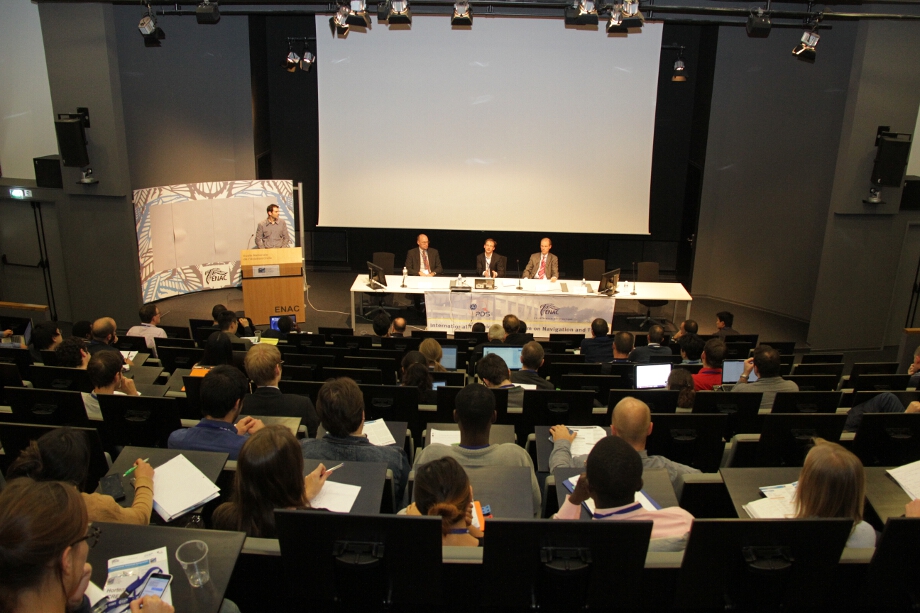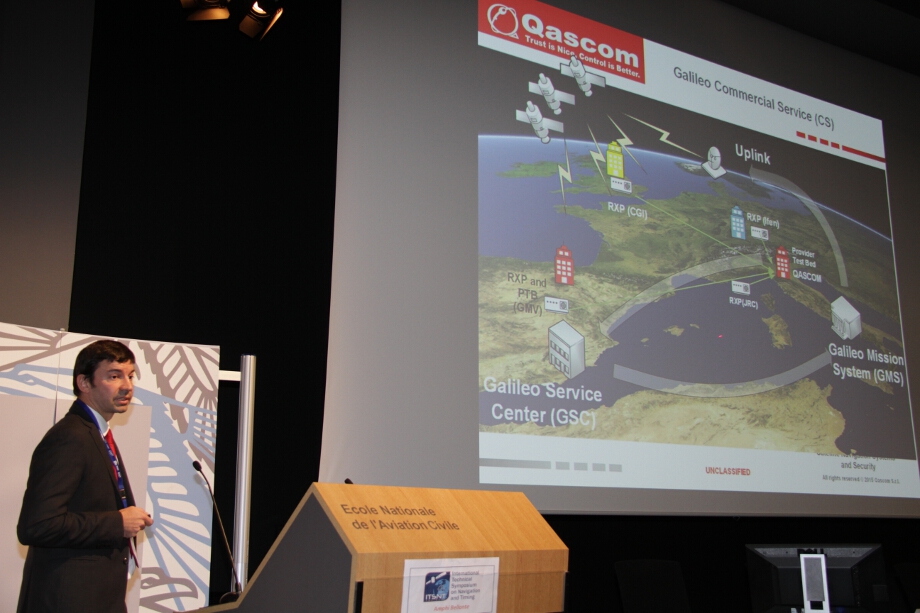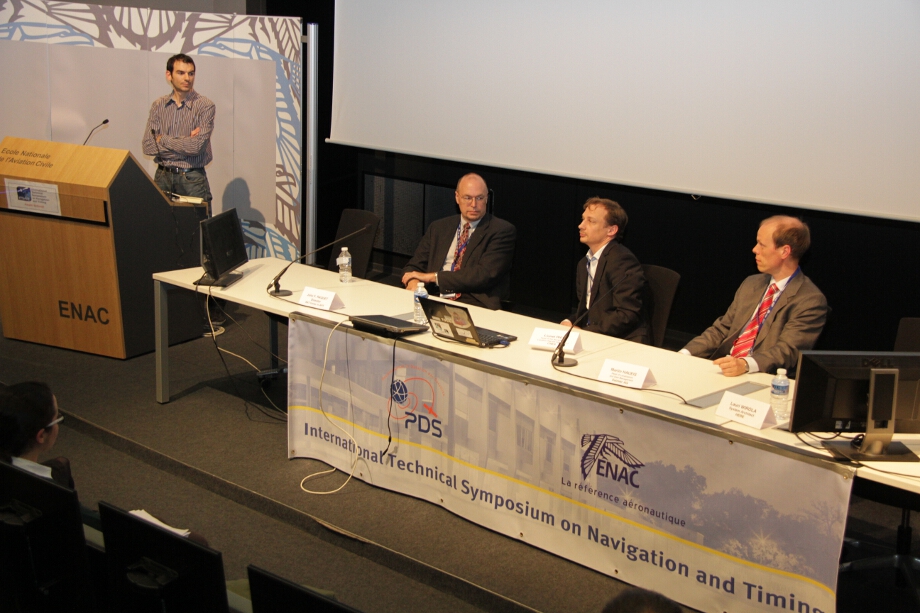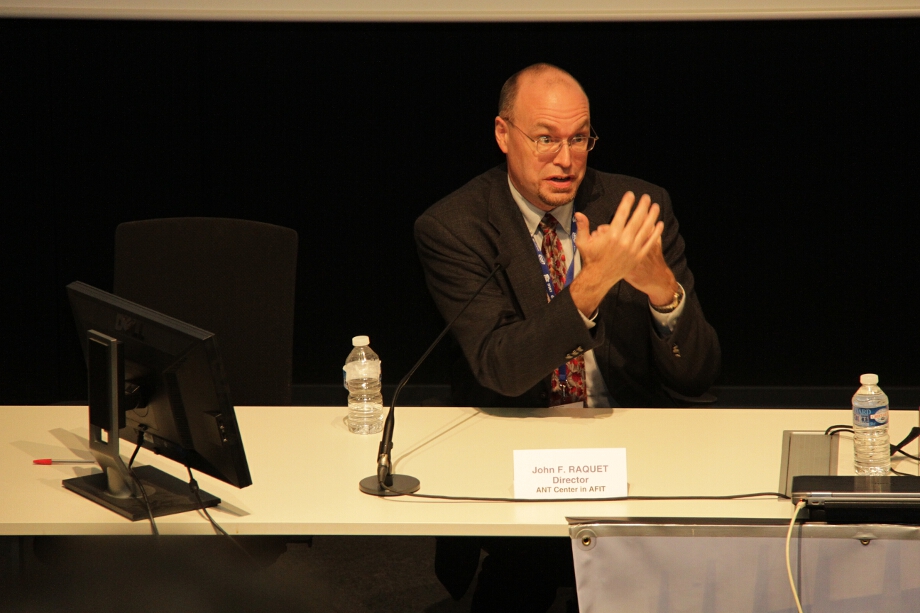Programme
The detailed programme of the International Technical Symposium on Navigation and Timing with abstracts can be downloaded here.
2015 Invited Speakers
- Dr. Martin Haueis: Head of Localization and Data Management, Daimler AG, Germany
- Dr. Christopher J. Hegarty: Director for CNS Engineering & Spectrum, MITRE Corporation, USA
- Sherman Lo: Senior research engineer, Stanford University, USA
- Mikael Mabilleau: Navigation services manager, Egis Avia, France
- Oscar Pozzobon: Founder and Technical Director, Qascom, Italy
- Prof. Mark L. Psiaki: Cornell University, USA
- Prof. John F. Raquet: Director of the Autonomy and Navigation Technology Center, US Air Force Institute of Technology, USA
- Lionel Ries: Head of the Navigation / Location Signals Department, CNES, France
- Francis Soualle: Navigation System Engineer, Airbus Defence and Space, Germany
- Dr. Morten Stakkeland: Development Engineer, Research and Development Navigation, Indra Navia, Norway
- A. J. Van Dierendonck: AJ Systems, USA
- Dr. Tech. Lauri Wirola: System Architect, HERE, Finland
- Ass. Prof. Zheng Yao: Tsinghua University, China
Media Partners
|
|
Sponsors

Bonus Videos from the ITSNT 2015
Dr. Christopher Hegarty from MITRE Corporation and Dr. Todd Walter from Stanford University were very kind to answer some GNSS-related questions asked by ENAC students. The videos are below
Interview with Dr. Christopher J. Hegarty
The questions asked by the ENAC students were
- Many GNSS signal innovations recently developed cannot be implemented in already-orbiting satellites and it takes time to replace a full GNSS constellation. Is there a target for the lifetime of a GNSS SV?
- What is the best way to enhance reliability of GNSS signals in front of jamming/spoofing and avoid scenarios like the one from the Newark airport (New Jersey)?
Interview with Dr. Todd Walter
The questions asked by the ENAC students were as follows
- What will be the impact of Multi-Constellation for civil aviation?
- What are the benefits/drawbacks for the WAAS ground segment of using GPS L1/L5 instead of GPS L1/L2?
- GPS is not well adapted to high latitude applications. What augmentations can improve accuracy in these regions?
The opening talk of the ITSNT 2015
The opening talk was given by Dr AJ Van Dierendonck from AJ Systems (USA).
Opening Talk
"Impacts of 42 Years of Experience on GNSS"
Dr. AJ Van Dierendonck, AJ Systems, USA
Session 1 - Positioning in Challenging Environments
"Role of Vision Sensors in Robust/Safe Navigation Systems"
Prof. John F. Raquet, Director of the Autonomy and Navigation Technology Center, US Air Force Institute of Technology, USA
""Positioning Needs and Associated Challenges for Autonomous Vehicles""
Dr. Martin Haueis, Head of Localization and Data Management, Daimler AG, Germany
""Precise Positioning in Urban Environment""
Dr. Lauri Wirola, System Architect, HERE, Finland 
"Technical Developments in GNSS Space Receivers"
Lionel Ries, Head of the Navigation / Location Signals Department, CNES, France
Session 2 - GNSS Signals and System Design
"Techniques for Spoofing and for Spoofing Mitigation"
Prof. Mark L. Psiaki, Cornell University, USA
"State of the Art in GNSS Authentication and Opportunities for System Evolutions"
Oscar Pozzobon, Founder and Technical Director, Qascom, Italy
"BeiDou Next Generation Signal Structure and Expected Performance – Challenges and Proposed Solutions"
Ass. Prof. Zheng Yao, Tsinghua University, China 
→ Answers to questions related to this presentation are available here
"Effects and Detection of Clock Failures for GNSS System Times based on Flying Clocks"
Francis Soualle, Navigation System Engineer, Airbus Defence and Space, Germany 
→ Answers to questions related to this presentation are available here
Session 3 - Air Navigation
"Next-generation GNSS Avionics Standards and Spectrum Protection"
Dr. Christopher J. Hegarty, Director for CNS Engineering & Spectrum, MITRE Corporation, USA
→ Answers to questions related to this presentation are available here
"Completing the Landing - Evaluating Continuity in GBAS"
Dr. Morten Stakkeland, Development Engineer, Research and Development Navigation, Indra Navia, Norway
"Horizontal Advanced RAIM: Operational benefits and future challenges"
Mikael Mabilleau, Navigation services manager, Egis Avia, France 
→Answers to questions related to this presentation are available here
"Resilient Alternative PNT Capabilities for Aviation to Support Continued Performance Based Navigation Operations"
Sherman Lo, Senior research engineer, Stanford University, USA 
Session 2 - GNSS Signals and System Design
BeiDou Next Generation Signal Structure and Expected Performance – Challenges and Proposed Solutions
By Zheng YAO, Tsinghua University, China
Q1: Is there any plan to incorporate signal authentication on B1C and/or B2 ?
A1: Security issues in satellite navigation are attracting more attention in recent years. In China, research on authentication features in signal structure is under way. However, before practical stage, plenty of research should be done to evaluate the possible degradation of other performance aspects. I suppose in the short-term BeiDou OS signals will not incorporate signal authentication information.
Q2: What is the message structure and channel encoding on B1C and B2 ?
A2: The message structure and channel encoding haven’t been released yet. Some options are under evaluation.
Q3: What is the design and the performance of the PRN codes selected on B1C and B2?
A3: Compared with BeiDou Phase II, in Phase III both B1C and B2 will use longer code sequences, with Gold-based or Weil-based structures. Due to some implementation constraints from spreading modulation options, code length also has more than one option. They are under evaluation. Some primary analysis for B2 are shown in the following paper: Zhu, Y., Yao, Z., Cui, X., Lu, M., "Comparative Analysis of Dual-Frequency Constant Envelop Multiplexing Techniques for ARNS Band," Proceedings of the 2014 International Technical Meeting of The Institute of Navigation, San Diego, California, January 2014, pp. 792-801.
Q4: What is the reason for deciding not to use GPS L1C or Galileo E1OS signal structure to offer easier integration in future multi-constellation receivers?
A4: All of QMBOC, CBOC, and TMBOC signals can be treated as BOC(1,1) in receiver processing. It is very easy to integrate them into a multi-GNSS receiver. The main reason for deciding not use CBOC is from the constraint of multiplexing complexity. In the potential solutions of B1C, pilot and data have 3:1 power ratio, and BOC(1,1) is used in data component. Under such constraint, CBOC in pilot component will significant increase the multiplexing loss and multiplexing complexity. Besides, patent risk is also taken into account.
Q5: What is the ACE-BOC spectrum with respect to Galileo's ALTBOC?
A5: It depends on the power allocation of those components in ACE-BOC. When the total power of upper sideband and lower side band are the same, ACE-BOC has a symmetrical PSD, which has approximately the same shape as AltBOC within the second sidelobe. More detailed analysis of ACE-BOC can be found in Zheng Yao, Jiayi Zhang, and Mingquan Lu, ACE-BOC: Dual-frequency constant envelope multiplexing for satellite navigation, IEEE Trans. on Aerospaces & Electronic Systems, Volume 52, Issue 2, 2016
Q6: Is B2a having the same central frequency as GPS L5/Galileo E5a?
A6: Yes
Q7: Will the Beidou signals generate correlation ambiguity at receiver level ?
A7: For B1C, MBOC option will introduce ambiguity threat into receivers. However, there are some solutions to eliminate such threat.
Q8: Is the BeiDou B1C not including secondary codes? Will it have a pilot channel?
A8: B1C has both pilot channel and data channel, and it has secondary codes on pilot
Q9: Will BeiDou keep the legacy signals on B1?
A9: Yes. At least for the duration of smooth transition.
Effects and Detection of Clock Failures for GNSS System Times based on Flying Clocks
by Francis Soualle, Airbus Defence and Space, Germany
Q1: What is the clock performance (Allan variance) in the range 10^0 to 10^2 s not shown in your figures?
A1: The stability (i.e. ADEV, HADEV) of the time scale (paper clock) obtained with the Kalman Filter can only be evaluated down to an observation interval "Tau" at least larger to the execution interval of the Kalman Filter (in the proposed example 30s). It must be underlined that the clock corrections models can be evalauted at an higher rate (e.g higher than 1/30s) based on oversampling (every second for example) of the predicted clock states derived from the estimated clock states of the KF (every 30s).
Q2: What size of phase jumps can occur?
A2: The lower bound for the Phase Jump which shall be detected have a typical order of magnitude of 10 to 15cm. For the frequency jump the typical order of magitude for the lower bound jump is 1E-12s/s. On figure slide 27, a jump of ~1.5ps/s is shown.
Q3: As an example, does a GPS-GALILEO EGNOS v3 user receiver need a 4 or 5 unknown navigation solution vector ?
A3: Standardisations recommend to apply the 5 unknown navigation solution to ensure accurate estimation of ISB. The introduction of this additional unknown might degrade accuracy of the 4 unknowns (X,Y,Z, T) for some configurations with limited non-GPS LOS (e.g. N GPS LoS and "only" one Galileo LoS).
Q4: What is the performance history of GALILEO clocks at this time ?
A4: Current G1G on-board CMCU rely on PHM (Master. Spec: 1E-12@1s. Measured: 0.8E-12@1s, see [1] "The Onboard Galileo Rubidium and Passive Maser,Status & Performance"), and RAFS (Back-Up Spec: 5E-12@1s. Measured: 3E-12@1s, see [1]). Future developments target three objectives: 1) Miniaturisation of existing PHM techno "mini-PHM" with same stability as current one, 2) higher reliability and Robustness against FE with the ONCLE and 3) development of a third on-board AFS technology with Optically Pumped Cesium (different techno to GPS CES. Spec: 3E-12@1s).
Q5: Is a random walk an appropriate model for a single satellite clock error?
A5: Models for the Clock Feared Events affecting the stochastic contribution usually consider Frequency Modulated White Noise (FMWN) and Frequency Modulated Random Walk (FMRW). Because Frequency Modulated Random Run (FMRR) can be observed at long-term, it becomes more difficult to distinguish it from drift, drift rate (deterministic) jumps.
Q6: Are the three clock faults all instantaneous shifts between states? Or is there a period of transition?
A6: "Instantaneity" of Clock FE is usually adopted/admitted.
Session 3 - Air Navigation
Next-generation GNSS Avionics Standards and Spectrum Protection
By Christopher J. Hegarty, MITRE Corporation, USA
Q1: I have a question regarding the design of GPS L1 C/A signal.
Using Eq. (5.55) of your book (which gives the bit error rate in function of the carrier to noise ratio and of the data rate), with C/N0 = 45 dBHz and a data rate of 50 bit/s, it gives a BER of 10^-277, which is extremely low. Why the data rate has not been increased to reduce the TTFF ?
A1: User receivers do not always experience such high C/N0s (i.e., 45 dB-Hz). Oftentimes the desired satellite signal is supressed due to the user, e.g., being inside a building or under foliage. And oftentimes the "noise" is enhanced (e.g., due to the presence of interference). The low C/A-code data rate allows for robust demodulation of the navigation data bits in most conditions when reliable carrier tracking can occur (typically ~27 dB-Hz for commercial receivers).
Q2: What would be the requirement to include a constellation if transmitting on a frequency closed to L1 or L5 but not completly centered on those frequencies? Will it be simply rejected in future standard ?
A2: The answer depends on the application. For civil aviation, a conformal antenna is required, and typical antennas are only a couple of cm in height. Stacked patches are the usual design solution, and it is difficult to make a dual-frequency patch cover more than ~20 MHz around each center frequency. Aviation would thus likely choose not to process GNSS signals that have appreciable energy beyond +/-10 MHz from 1575 and 1176 MHz. Other users may choose to use signals that are spaced farther in frequency. For instance, survey equipment today uses much larger antennas than can be made to cover wider bandwidths without trouble. Such equipment is already, today, processing ALL GNSS signals from 1164 - 1300 MHz and 1559 - 1610 MHz.
Q3: What is your vision and appropriate, or should I say, proportionate responses to have against jamming/spoofing threats ?
A3: The answers depends on the application. Proportionate responses for the military includes using large/expensive equipment such as 7-element controlled reception pattern antennas (CRPAs) for high-valued platforms and sophisticated interference detection/supression hardware and algorithms. Civil users are generally not willing to invest so much in cost/weight. This situation is only likely to change if the users believe the threat is likely to affect their missions.
Q4: What's the US position on use of MC and specifically Galileo in WAAS? Any plans For Galileo corrections and monitoring?
A4: Official U.S. policy can be found in the 2004 "U.S. SPACE-BASED POSITIONING, NAVIGATION, AND TIMING POLICY", which can be readily found on the Internet. To my knowledge, the FAA is not at the current time planning on an expansion of WAAS to provide corrections for any other system beside GPS. This program direction is driven entirely by consideration of costs/benefits, and the FAA is otherwise supportative of multiconstellation GNSS for civil aviation, as demonstrated by their support to ICAO, RTCA, and EUROCAE standardization activities.
Q5: What are the biggest challenges of the SBAS DF MC standards updates?
A5: There are many moving parts -- four global constellations, new user equipment algorithms and potential modes of operation. All of these need to come together within the standards. Perhaps the biggest challenge is that the constellation deployments are not within control of the aviation industry, so the development schedules and service performance commitments will need to be mostly accepted "as is", and we will have to develop SBAS standards to work around any constellation-specific idiosyncrasies.
Q6: Is the update of SBAS standards aiming at new operations? Or Otherwise what are the goals of these updates?
A6: Multiconstellation dual frequency (MCDF) SBAS will have to provide benefits for civil aviation to pay for it and adopt its use. Potential benefits are still being studied may include new operations, or simply improved performance (e.g., higher availability) for current operations.
Horizontal Advanced RAIM: Operational benefits and future challenges
By Mikael Mabilleau, Egis Avia, France
Q1: Is there any simulation results that could be shared that shows the increase in computational load in function of Pconst/Psat?
A1: This aspect has not been investigated but additional activity will be shared in the frame of the EUROCAE WG62 on ARAIM performance using a simplfied algorithms limited the CPU
Q2: Do the simulations take account of the nominal outage probabilities specified in the GPS SPS? And for Galileo?
A2: The simulations take into account the probability of satellite failures specifies in GPS SPS but do not take into account the satellite availability probability to be healthy in a GPS nominal slot. For Galileo, a sensitivity analysis has been conducted for the satellite failure probability assuming 100% availability of the satellites in their slots (same assumption for Galileo than the one used for GPS).
Q3: What's the motivation in having a constellation failure probability for rnp 0.1 when today we assume no such failure for RAIM?
A3: No safety analysis has been run that assess if the constellation failure event shall be discarded from the external threat. We made the choice to include it for RNP 0.1 NM performance assessment. The GPS commitment on GPS constellation failure may validate that the current RAIM algorithms are still valid but it is under question for other constellation having a less stingent constellation failure figure.
Q4: Have you investigated the effects on continuity performance when using Multi-Constellations H-RAIM ? Do you think it can compete with GPS hybridized with inertia?
A4: The continuity performance has not been fully covered in the present analysis but this is an interesting question. GPS hybridised with inertia may have better fall back mode than ARAIM.
Q5: Do you think that using other constellations such as Beidou or Glonass than Galileo would provide equivalent performance ?
A5: I believe that the results will be the same for what concern H-ARAIM performance considering the magnitude of the alert limit.
Q6: In your slide 22: why the performance is degraded with 27 GPS + 24 GAL?
A6: Investigations have been conducted to clarify this result and indeed for 99% statistics, a degradation is observed. This is linked to the augmentation of the subsets due to the increase number of satellite with a non-negligeable Psat and Pconst.
Q7: How will SBAS and ARAIM co-exist? Will ARAIM mean SBAS decommisioning in the long term?
A7: This is not the case. My personnal feeling is that the ARAIM vertical concept will merge in the future in an evolution of the DFMC concept. ARAIM and SBAS will definetly co-exist in the short term standards to be developed in 2020+ assuming that the SBAS will be used for precision approach and ARAIM as back up when the SBAS is not available.
Q8: Are iono failures critical for the rnp 0.1 operations? If so what is the threat model?
A8: Iono failure should be defined. The results provided focus on DFMC systems which means that the iono delay is assumed to be corrected by iono-free combination. ARAIM and RNP0.1 will be sensitive to scintillation but no model has been defined for the moment to characterise the impact and robustness of ARAIM against scintillation.

